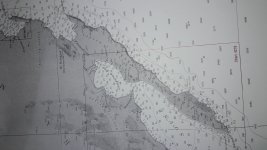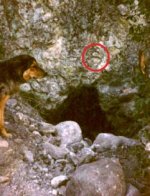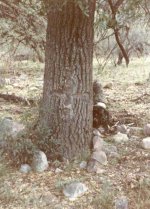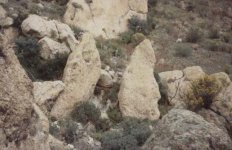Al D
Bronze Member
Great score, that book is invaluable.got me a 1948 copy of Antonio Vasquez de Espinoza's book
Great score, that book is invaluable.got me a 1948 copy of Antonio Vasquez de Espinoza's book


King Charles 3rd of Spain (1716-1788) issued secret orders 1767 to start removing the Jesuits. It is worth noting that the suppressing of the Jesuits was nothing new it had been going on in Portugal and France already.
The Spanish Kings orders reached Manila on May 17th 1768. For the next few years the Jesuits were transported back to Spain then on to Italy
I cant help thinking that the Jesuits by this time knowing their time was up did not make arrangements to move on with what wealth they had. Mexico was removing priests etc in 1767 this would have been known in the Philippines. There is little chance the colonial garrison would of given them safe passage and surely would of demanded some sort of fee.
The Jesuits were all over the Philippines. One place which was regarded as a frontier for them was Casiguran north east of Manila. It is still fairly remote place today. The port there was used a lot by many ships mostly for shelter or quick resupply and of course Manila galleons coming from Mexico used it. To leave from somewhere like this unnoticed would not of been difficult.
So with reference to the Philippines and whether any Jesuit treasure is to be had I think quite possibly there is little or nothing to be found that belonged to them but haha did they think they were coming back? were they caught off guard and were rushed? were they forced to bury their wealth? Who knows.
View attachment 1796135 View attachment 1796135





Deducer:
Why would you ask this question when it has been answered several times in the past?
Remember this:
View attachment 1797924
Mike
How does that prove that there is such a thing as Jesuit treasure?
Deducer wrote
Well between us, we are 'preaching to the choir' for I think we have largely the same conclusions where the Jesuits are concerned. I thought we had a person whom had 'jumped in' to the discussion without bothering to read the 150 + pages of discussion previous, so attempted to sum up the case in one post. A side point here but I have found your posts to be every bit as informative as well, and thank you for the kind words.
To our skeptics - what about the famous silver of San Xavier del Bac? Of course one could make the argument that it was Franciscan and not Jesuit, for it was not mentioned as being seen during the Jesuit period, however not much was mentioned about what was in any of the Jesuit missions during their tenure in Pimeria Alta. We have the statements from father Nentvig and Och that all of the remote and minor visitas were richly ornamented, perhaps in scale to the more magnificent churches, but some of you dismiss those descriptions out of hand.
In favor of the silver at San Xavier del Bac being Jesuit, we can look at the letters of father Segesser; he mentioned being in the silver mountains, and complained at having little in the way of silverware, implying that silver was plentiful enough yet actual useful silver items were still rare. He also complained of the inability to work the mines in safety, which indicates that the mines were being worked when possible. Then there is the slag built into the Franciscan structure seen by visitors today - the fact that it is built into the Franciscan structure, certainly implies that it was available to use when they were building the structure, so probably predates the arrival of the Franciscans.
Also, while the mission was not under Jesuit control when the early American visitors saw the impressive silver on display, the silver was again removed and hidden, but was brought out on the arrival of several Jesuit priests, showing that they had safe-kept the ornaments of the church in the absence of the padres. If the silver had not belonged to the Jesuits in the first place, why should the Pimas have made such a point to trot the valuables out to show to the padres on their arrival?
If the estimates of the people who saw the silver are at all accurate, and I see no reason to dispute that it was, $40,000 circa mid-19th century, today it would be worth nearly twenty times that just for melt value; is not a treasure worth say $750,000, a treasure worth hunting? To say nothing of the silver mine that produced the metal used for these ornaments and altar!
Just trying to point out, that even if we ignore the numerous business concerns and profits from them, and the rest of the mining activities and products thereof, just in San Xavier del Bac, we have a respectable treasure linked to the padres, worth hunting for, just as we have a much smaller value treasure of at least two missions (Guevavi and Tumacacori) in the rather un-exciting bells they produced. I strongly suspect that if you could locate where the bells are hidden, you might well find other "ornaments" of these churches, not to mention any amassed precious metals as well.
Igadbois - great post, yet where are those bells today?Can we conclude that making three bells, also produced some 120 tons of slag?
Good luck and good hunting, I hope you find the treasures that you see
Oroblanco
 The treasure stories are for real and there legendary tales are what caused the great mining booms of the West.
The treasure stories are for real and there legendary tales are what caused the great mining booms of the West.  The last of the Tumacacori Treasure was found in the in 1972 by professional treasure hunter Charles Kenworthy and it amounted 1038 silver bars near Sardina Peak. It took me 11 years to learn the truth about Tumacacori and its illusive treasure. Keep on hunting, cause you never know wat your going to find out in them thar hills!!! "Bust Or Riches!!!" Hard Rock Bob
The last of the Tumacacori Treasure was found in the in 1972 by professional treasure hunter Charles Kenworthy and it amounted 1038 silver bars near Sardina Peak. It took me 11 years to learn the truth about Tumacacori and its illusive treasure. Keep on hunting, cause you never know wat your going to find out in them thar hills!!! "Bust Or Riches!!!" Hard Rock Bob 
The San Xavier Treasure was found in 1928 and it was used to build a taco factory in Tucson. It was a Franciscan treasure. The Tumacacori Treasure was found in 1934 in Loco Canyon in the Tumacacori Mountains and the underground rooms were found in the same canyon in 1912, and later re-found in 1954 where the church artifacts, such as the bells, were stored. It also, was a Franciscan Treasure. There were three missionary periods in Arizona: the early Franciscan Period, the Jesuit Period and the later Franciscan Period. Corral Pepper wrote a story in Desert magazine In August 1980 where a document known as a relacion recounted the story of Spanish soldier with the Onate Expedition in 1596 arriving at a mission named Tumacacori De Cerritas: meaning Tumacacori of the foothills or ceremonial hills. Today it's known as the Palo Parado site, which is considered the oldest Franciscan mission in the United States. The padres were working what it referred to as the Virgin De Guadalupe Mine. It's believed the Pima Indians originally discovered and they worked the mine the Spaniards later confiscated and forced them to work in as their slaves. Eventually, the resourceful Pimas rebelled and the killed the Spanish intruders, which was discovered during excavations at the site by the Amerind Foundation. To be politically correct the prestigious organization linked the ruins to the Jesuit Padre Kino, which was an outright lie. The original church faced east to west in the style of an early Franciscan church with the sleeping quarters and eating quarters on both sides of the chapel with an arched porch. The Jesuits had nothing to do with these two treasures. However, Kino had a gold mine on the black mountain southwest of the present San Xavier church. Around 1911 there was an article that talked about the mine. I believe there's an arched tunnel at the base of the mountain on the northwest side and you can still see where somebody had been blasting on the peaks above. There's also markings on top of the gold bearing mountain to this day. One of the carvings depicted an Indian aiming a bow an arrow towards a burial site on the mountain. So There You go Youngsters! Eat your heart out!!!!The treasure stories are for real and there legendary tales are what caused the great mining booms of the West.
The last of the Tumacacori Treasure was found in the in 1972 by professional treasure hunter Charles Kenworthy and it amounted 1038 silver bars near Sardina Peak. It took me 11 years to learn the truth about Tumacacori and its illusive treasure. Keep on hunting, cause you never know wat your going to find out in them thar hills!!! "Bust Or Riches!!!" Hard Rock Bob

 The S means look in the distance in Spanish, which is south of the mark. This also is a Spanish Tunnel.
The S means look in the distance in Spanish, which is south of the mark. This also is a Spanish Tunnel.
 This is Maltese Cross meaning the Tumacacori treasure is buried nearby.
This is Maltese Cross meaning the Tumacacori treasure is buried nearby.
 These two peaks mark the mine, as mentioned in the ancient manuscript known as the derrotero (directional chart). The treasure was found by the Beltrans from California. They had a map dated 1834, which went along with a stone plaque at Fresno Spring. My partner talked to one of the original treasure hunters before he died and all he would say is there were leather sacks full of gold nuggets that were so brittle they had fallen apart leaving their contents on the floor.
These two peaks mark the mine, as mentioned in the ancient manuscript known as the derrotero (directional chart). The treasure was found by the Beltrans from California. They had a map dated 1834, which went along with a stone plaque at Fresno Spring. My partner talked to one of the original treasure hunters before he died and all he would say is there were leather sacks full of gold nuggets that were so brittle they had fallen apart leaving their contents on the floor.
I know of nothing more evil than jesuits and what they uphold.Okay,
THE ONLY THING I ASK OF ANYBODY BEFORE POSTING, IS THAT THEY READ THE ENTIRE POST FIRST
(I know it is long, but it contains a lot of referenced information)
Here we go with one of the all-time most contentious subjects in all of the Treasure Hunting World:
Hidden/Lost Jesuit Treasures
Funny thing, as I write this, the movie National Treasure just came on! HAHAHA
Where to start, where to start, where to start? I guess I should start with what might constitute a Jesuit Treasure;
1. Gold and Silver Bars, Coins and the like.
2. Candlesticks, Monstrances, Ciboria, and various other Church Vestments made of precious metals in quantities large or small.
3. A combination of numbers 1 and 2.
4. The exploration of the areas, conversions of the heathens, and aid they rendered to those converted.
First, nobody can argue that number 4 is not absolutely true. Both the spiritual and exploratory work they did from 1608 until their expulsion in 1767 was a wonder for the ages. An example of how a small group of determined people can make such extraordinary advances in the knowledge base of mankind and bringing the light of God into the hearts of so many people in a frightening new world. One has only to read about Padre Kino SJ and his changing of world maps that previous to his explorations showed California as an island. He was the first to contradict that idea. Other testaments lie in all the missions that were manned by the tiniest number of Jesuit Fathers in some of the most hostile territory on Earth. Many of them gave their lives in the most gruesome manners imaginable at the hands of those that fought the changes they wanted to bring.
Next, I would like to talk about number 2. Of all the Jesuit Treasures, this possibility is the most believeable to most people who are of a more skeptical bent. While some diehards do not believe that even these are possible, I give you the words of one of the most DIE HARD of all Jesuit Treasure Skeptics: Father Charles W. Polzer SJ; in the Aug 1962 edition of Desert Magazine, as part of a larger article on preserving the old missions and other historically significant places he writes:
While he does go on to say that no Church records have been found that verify this possibility, he DOES say that it is a possibility. For those of you who know Father Polzer's stance on the subject, it was indeed a revelation to me when I first read it.
We need to know why the Jesuits would want to amass such wonderous vestments in the first place. In some miserable mud hovel in an arid remote hostile desert setting, what would be the great need to have such things? Well, Father Johann (Juan) Nentvig SJ, in his book "Rudo Ensayo" spells it out so that even a person not having any secret Church knowledge can understand:
There you have it! A Jesuit Father himself quoting the very words of the Founder of the Jesuit Order: SAINT Ignatious Loyola! So, now we know WHY the Jesuits would want to accrue such beautiful and costly appointments, but do we have any evidence, other than what Father Polzer SJ calls a "possibility"? You bet your sweet bippy we do! We have the words of some of the Jesuit Fathers themselves. Why don't we start with our old friend, Father Johann Nentvig SJ (again from Rudo Ensayo):
That's pretty good. Anything else? You betcha! Why don't we read the words of Father Joseph Och SJ, in a passage from his journals (Missionary in Sonora; the travel reports of Joseph Och, S.J., 1755-1767):
WOW! THAT'S AMAZING! Right from the horse's mouth. Let me here add a couple of points of fact so that the reader can make a more informed decision:
1. Father Nentvig's Journals are beyond reproach. There is no doubt he wrote the words that I have attributed to him.
2. Father Och's Journals are not 100% attributable. We know that he put them all together during his final years while he lived at the Jesuit College at Wurzburg, Bavaria. He passed away in 1773. Thirty-six years after his death in 1809, a book called "Der S.J. in Neumexico. Nachrichten von seinem Reisen nach dem Spanischen Amerika, seinem dortigen Auftenthalte vom Jahr 1755 bis 1767, und Rückkehr nach Europa 1768. Aus dessen eigenhändigen Aufsätzen" was published. These were the collected writings of Father Och SJ. His journals were kept at the Jesuit College in Wurzburg until most of the city was destroyed in an Allied Air Raid in 1945. I have not personally been able to locate them after that. So, while it is remotely possible that some parts of his journals MAY not have been written by Father Och, all one has to do is to read the entire book translated by Theodore E. Treutline to understand that it is HIGHLY unlikely that those were not the actual writings of Father Och SJ. I ONLY included this in the interest of being intellectually honest in what I say (unlike some). A final note about this journal's authenticity: While Lamar may have his doubts (whoever Lamar may be), the two most eminent Jesuit Historians of North America (Father Ernest J Burrus SJ and Father Charles W Polzer SJ have both worked on Theodore Treutline's Translation of "Der Glaubenspredigers ~" and neither of them seem to have any doubt whatsoever that those are the true and correct journals of Father Och SJ, and Theodore Treutline himself one of the most prolific translators of German Jesuit Writings did not doubt their veracity. I guess Lamar holds himself in very high regard. HAHAHA
Now. let us move on to numbers 1 and 3. There are no historical documents stating that the Jesuits possessed ANY stores of gold and/or silver bars, coins, etc. What we have, are a couple of documents that are SUPPOSED to be inventories of treasures that were hidden before the Jesuits were expelled from the New World during the night of 25-26 June 1767. Those who are familiar with histories written by Father Ernest J Burrus SJ, Father Charles W. Polzer SJ, Traditional Historians, and most history books detailing Colonial Spanish times in the New World are right now saying "THAT IS IMPOSSIBLE! King Charles III made certain that his orders to arrest all the Jesuits, march them to the sea, and ship them all back to Europe, were sealed and COMPLETELY secret until the day they were to be arrested! WRONG! Well, not completely wrong. They were supposedly a secret to everybody that received the King's Letters. There are a few little niggling facts that keep getting omitted from most of that history you have read. Surprised? I was!
First, here is a bit from the official history of the City of Guanajuato, Mexico:
While this in itself is not a smoking gun (so to speak), it does show that it MAY have been possible for the Jesuits to have received some advanced warning from those seculars who had allegiances to the Jesuits.
Here is something a more concrete. It's not a quote or something vague. It is simply an historical fact that keeps being either omitted or ignored by traditional historians:
The Jesuits knew without doubt what was coming! How do we know this? Very simply, the Jesuit Expulsions from all of Spain's Holdings around the world was not the only nor indeed the first of the Jesuit's Expulsions:
1. Due to Jesuit Involvement in Portuguese Rebellions, they were expelled from all of Portugal's lands around the world on 06 July 1758. A full nine years before their Spanish Expulsion!
2. Due to the same intrigues, in November of 1763, the French King dissolved the Jesuit Order in all French Holdings worldwide. Four years before their Spanish Expulsion!
3. Due, again, to more of the same intrigues, Spain and it's colonies (European), and it's principalities (Naples) arrested all the Jesuits during the night of 1-2 April 1767, and in Spain's Holdings worldwide on the night of 25-26 June 1767.
4. After a Papal Threat, the Kingdom of Parma expelled the Jesuits and dissolved their Order in 1768.
So, due to the earlier expulsions from everywhere else in the world (except Russia and Prussia) by the year 1763, there is little doubt that the Jesuit Order knew FAR in advance of 25-26 June 1767 that the very same fate would befall them in Spanish Lands in time. They had YEARS to hide all their great accumulated wealth.
Now, we move on to examine one of those supposed Jesuit Treasure "proofs". It has come to be known as the Molina Document and the associated Molina Map. It was said to be the product of a Sister Michaela Molina. While she was serving at an Archive in Rome, she supposedly came across a document that detailed a HUGE Cache of Jesuit Treasure that was buried near the Tumacacori Mission in the Santa Cruz River Valley. She was said to have hand copied the document and kept it a secret until she moved to the United States. There are a couple of problems with that document:
1. There is no extant record of any Sister Michaela Molina. There is a Molina Family that lives nearby, and their family history says there was a Michaela Molina. Nothing hard though.
2. The document and map were unknown until about 1933 when John D. Mitchell wrote about it. We know from the Stone Maps story that it could have been around, but kept a secret for many years before that, because of the nature of the information contained in the document. It is the contention of the National Park Service and the Jesuit Order that John D. Mitchell either had the document made or was defrauded by someone who knew he was a treasure hunter. The NPS gives many reasons for the document to be labeled a hoax/fraud. The main ones are the orientation of the page and the writing. They seem to miss the part of the story about where Sister Molina HAND COPIES her document from the original.
Here is a link to the TNet Thread on this subject:
http://forum.treasurenet.com/index.php/topic,41291.msg1842925/topicseen.html#msg1842925
That's about all for now, as I am VERY tired of typing.
Best-Mike